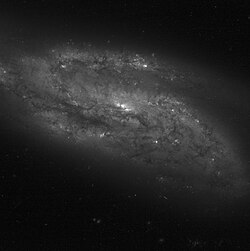Astronomy:NGC 4088
| NGC 4088 | |
|---|---|
 NGC 4088 with the Hubble Space Telescope | |
| Observation data (J2000 epoch) | |
| Constellation | Ursa Major[1] |
| Right ascension | 12h 05m 34.2s[2] |
| Declination | +50° 32′ 21″[2] |
| Redshift | 0.002524[2] |
| Helio radial velocity | 757 ± 1 km/s[2] |
| Distance | 51.5 ± 4.5 Mly (15.8 ± 1.4 Mpc)[3] |
| Apparent magnitude (V) | 11.2[2] |
| Characteristics | |
| Type | SAB(rs)bc[2] |
| Apparent size (V) | 5.8′ × 2.2′[2] |
| Other designations | |
| UGC 7081,[2] PGC 38302,[2] Arp 18,[2] VV 357[2] | |
NGC 4088 is an intermediate spiral galaxy in the constellation Ursa Major. The galaxy forms a physical pair with NGC 4085, which is located 11′ away.[4]
General information
NGC 4088 is a grand design spiral galaxy.[5] This means that the spiral arms in the galaxy's disk are sharply defined. In visible light, one of the spiral arms appears to have a disconnected segment. Halton Arp included this galaxy in the Atlas of Peculiar Galaxies as one of several examples where this phenomenon occurs.[6]
NGC 4088 and NGC 4085 are members of the M109 Group, a group of galaxies located in the constellation Ursa Major. This large group contains between 41 and 58 galaxies, including the spiral galaxy M109.[7][8][9]
Supernovae
Three supernovae have been observed in NGC 4088. The first was discovered on 10 February 1991, SN 1991G (Type II, mag. 17).[10]
On April 13, 2009, supernova SN 2009dd was discovered in NGC 4088.[11] At apparent magnitude 13.8,[11] it became the third-brightest supernova of 2009.[12]
On 16 May 2022, SN 2022jzc was discovered (Type II, mag. 17.8).[13]
References
- ↑ R. W. Sinnott, ed (1988). The Complete New General Catalogue and Index Catalogue of Nebulae and Star Clusters by J. L. E. Dreyer. Sky Publishing Corporation and Cambridge University Press. ISBN 978-0-933346-51-2.
- ↑ 2.00 2.01 2.02 2.03 2.04 2.05 2.06 2.07 2.08 2.09 2.10 "NASA/IPAC Extragalactic Database". Results for NGC 4088. http://nedwww.ipac.caltech.edu/cgi-bin/nph-objsearch?objname=NGC+4088&img_stamp=yes&extend=no.
- ↑ "Distance Results for NGC 4088". NASA/IPAC Extragalactic Database. http://nedwww.ipac.caltech.edu/cgi-bin/nDistance?name=NGC+4088.
- ↑ A. Sandage; J. Bedke (1994). Carnegie Atlas of Galaxies. Washington, D.C.: Carnegie Institution of Washington. ISBN 978-0-87279-667-6.
- ↑ "Arm classifications for spiral galaxies". Astrophysical Journal 314: 3–9. 1987. doi:10.1086/165034. Bibcode: 1987ApJ...314....3E.
- ↑ H. Arp (1966). "Atlas of Peculiar Galaxies". Astrophysical Journal Supplement 14: 1–20. doi:10.1086/190147. Bibcode: 1966ApJS...14....1A.
- ↑ R. B. Tully (1988). Nearby Galaxies Catalog. Cambridge: Cambridge University Press. ISBN 978-0-521-35299-4.
- ↑ A. Garcia (1993). "General study of group membership. II - Determination of nearby groups". Astronomy and Astrophysics Supplement 100: 47–90. Bibcode: 1993A&AS..100...47G.
- ↑ G. Giuricin; C. Marinoni; L. Ceriani; A. Pisani (2000). "Nearby Optical Galaxies: Selection of the Sample and Identification of Groups". Astrophysical Journal 543 (1): 178–194. doi:10.1086/317070. Bibcode: 2000ApJ...543..178G.
- ↑ Transient Name Server entry for SN 1991G. Retrieved 21 March 2023.
- ↑ 11.0 11.1 "Supernova 2009dd in NGC 4088". Astronomy Section, Rochester Academy of Science. 2009-12-30. http://www.rochesterastronomy.org/sn2009/sn2009dd.html.
- ↑ David Bishop. "Bright Supernovae - 2009". supernovae.net (International Supernovae Network). http://www.supernovae.net/sn2009/.
- ↑ Transient Name Server entry for SN 2022jzc. Retrieved 21 March 2023.
External links
- Light curves and spectra of SN2009dd on the Open Supernova Catalog
- NGC 4088 on WikiSky: DSS2, SDSS, GALEX, IRAS, Hydrogen α, X-Ray, Astrophoto, Sky Map, Articles and images
Coordinates: ![]() 12h 05m 34.2s, +50° 32′ 21″
12h 05m 34.2s, +50° 32′ 21″
 |


